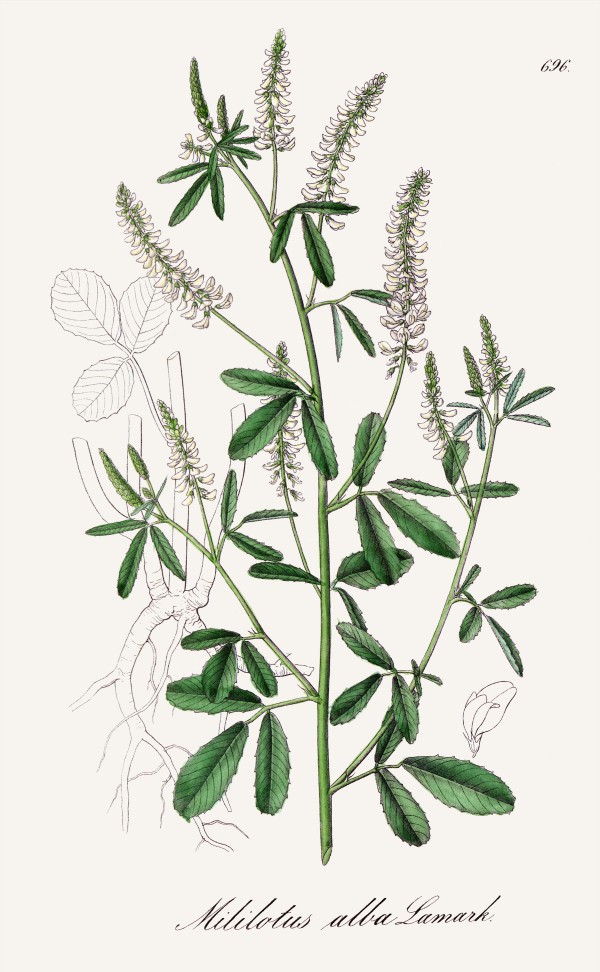Melilotus albus Medik. - syn.Melilotus leucanthus Koch ex DC. - Fabaceae
white melilot, white sweet clover, Bokhara clover, Weißer Steinklee, Bokharaklee
Annual or biennial herb, native to Europe, Asia and North Africa, cultivated and naturalized in North America; leaves trifoliate, serrate; flowers white, 3.5-5mm long.
http://www.efloras.org/florataxon.aspx?flora_id=2&taxon_id=200012216
„Its characteristic sweet odour, intensified by drying, is derived from coumarin… It is favored for honey production and for its nitrogen fixing ability in preparing agricultural soil for future crops.“
http://en.wikipedia.org/wiki/Melilotus_albus
„Anthoxanthum species are unusual among British grasses in their content of coumarin, a compound whose presence in sweet clover (Melilotus alba) has been alleged to give rise to the production of the anticoagulant dicoumarol in “sweet clover disease”. By chromatographic and spectrophotometric techniques, 7-hydroxycoumarin 6-glucoside (aesculin) and o-hydroxyhydrocinnamic (melilotic) acid, trans-2-hydroxycinnamic (o-coumaric) acid, and 4-hydroxycinnamic (p-coumaric) acid were found in annual sweet vernal (A. puelii) and sweet clover. 3-Methoxy-4-hydroxycinnamic (ferulic) acid was also found in annual sweet vernal, and 7-hydroxycoumarin in sweet clover.
Dicoumarol formation was studied in spoilt (i.e., mouldy) hay made from perennial sweet vernal (Anthoxanthum odoratum). The hay contained very small amounts of dicoumarol, and larger amounts were present when the hay was inoculated with Penicillium jenseni and when formaldehyde was added. During spoilage the coumarin content of the hay decreased while the related compounds increased in amount and reached a steady value in about 4 weeks.
Although the coumarins and related compounds of annual sweet vernal and sweet clover are virtually the same, much higher levels of dicoumarol were found in the latter after spoilage, possibly because, under the conditions of the experiment, it became more mouldy than the former.
Experiments with a mixed oatgrass/cocksfoot hay indicated that added trans-2-hydroxycinnamic acid and not coumarin gave rise to 4-hydroxycoumarin which reacted with formaldehyde to produce dicoumarol. This suggests that this acid and not coumarin is the precursor of dicoumarol.“
[Coumarin and related compounds of Anthoxanthum puelii and Melilotus alba and dicoumarol formation in spoilt sweet vernal and sweet clover hay., Davies, E.G., Ashton, W.M., Journal of the Science of Food and Agriculture, Vol.15(11), 1964, 733-738]
„Dicoumarol, which is still called every now and then as an ingredient of Melilotus alba, occurs either in the plant, nor is formed by plant enzymes. It arises from incorrect storage under the influence of microorganisms. Cattle feeded with moldy clover hay which was stored wet, develope an illness called 'sweet clover disease'. Blood coagulation tendency is greatly reduced.“
[Hagers Handbuch der Pharmazeutischen Praxis, Springer 2010]

Melilotus albus Medik. as Melilotus alba Lam.
Dietrich, A.G., Flora regni borussici, vol. 10: t. 696 (1842)
http://plantgenera.org/species.php?id_species=655064
Melilotus albus
© Rolf Marschner (2004),
www.botanische-spaziergaenge.at

